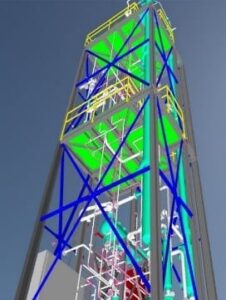What do you need to know to start designing distillation columns?

The process information you need is:
- Properties of your distillation feed, including:
- Composition:
- Solids?
- Non-condensables?
- Azeotropes?
- Feed rate and temperature
- Materials of Construction
- Composition:
- The desired heating and cooling mediums
- The operating temperature range you wish to achieve during heating, separation and cooling
- Your target operating pressure range during heating, separation and cooling
- Desired end product specifications
- Chemical composition
- Purity requirements
- Recycle and waste stream properties, including:
- Acceptable stream composition?
- Will further processing be required?
The answers to these questions will depend on what your separating, what your current facility looks like, and how much you are intending to invest in the project. Some information may already exist if you are doing a common separation. Many firms start with a lab-scale experiment to gather data on the substances they intend to separate on a small scale before moving to full column design. Try our distillation column specification sheet or:
How to Design a Distillation Column: Best Practices
Distillation column design best practices are guidelines to help you size and design distillation columns that perform optimally within your process parameters. The starting point of all column design is to determine the relative volatility of the key substances to be separated. Using a mass and energy balance simulation program the physical and chemical properties of the substances you are trying to separate are modeled and the following ratios are applied to determine final column design:
- Fs Vapor – Vapor factor ratio. This is used as a starting point for column sizing and adjusted with the other ratios.
- GPM/FT2 Liquid – liquid gallons per minute divided by the column area. This is used for preliminary equipment sizing.
- Entrainment or Reflux Ratio – measurement of the amount of liquid that passes from tray-to-tray or stage-to-stage up the column.
- Flood Ratios, including Downcomer Flood and Jet Flood ratios – These measure the accumulation rate of liquid in the column and help determine tray spacing, placement and hole size.
- Weeping Point/Dump Point or Turndown Ratio – This is the point at which liquid starts falling back through the column from each stage or tray. It helps determine ideal column pressure.
- Column Efficiency (for trayed columns) – this is usually a measurement of vapor rate vs. weeping and entrainment rates. It can effect column sizing and stage/tray spacing.
- HETP – Height Equivalent pf a Theoretical Plate (for packed columns) – based on the McCabe-Thiele diagram theory, this helps you determine how many required stages will be needed to achieve separation in a packed column and affects column sizing.
Once these ratios have been determined, adjustments in column performance and design tradeoffs can be explored in simulation to come up with a final optimized version. It is recommended that you use a experienced distillation column design build firm, like EPIC systems 314-806-1678 to complete distillation system design. These process experts can help you run accurate simulations to find optimal column design, material balances, and navigate operating tradeoffs.
EPIC’s Column Design & Build Capabilities
How can we help with your column design? Learn more about our distillation capabilities, or contact us 314-806-1678 to get started.
Further resources for column design and sizing:
- Distillation project planning sheet
- A lengthy guide for engineers from Research Gate
- Video Tutorial of distillation column desn ign
- A handy cheat-sheet for the design ratios
- Sulzer’s guidelines for optimal column design
- Costello’s explanation of basic design principles


